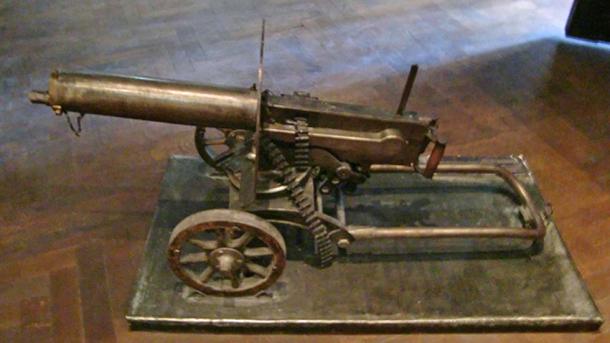
Might Makes Right on the Field of Death: The Bloodsoaked Battle of Omdurman — Part II
The British forces watched for the enemy to get within yards before opening up their artillery. They waited, breath held, for the Dervishes to cross into the killing zone.
As the Dervish warriors barreled forward, the British forces and their allies opened artillery fire. A young war correspondent working for the Morning Post, Winston Churchill describes the artillery bombardment saying, “About twenty shells struck them in the first minute.” He goes on further to say “Some burst high in the air, others exactly in their faces. Others, again, plunged into the sand and, exploding, dashed clouds of red dust, splinters, and bullets amid their ranks.”
However, the artillery barrage did not faze the Sudanese Dervishes, as they charged forward shouting, “There is no God but Allah and Muhammad is the messenger of Allah.”
Churchill further states:
“It was a terrible sight, for as yet they had not hurt us at all, and it seemed an unfair advantage to strike this cruelly when they could not reply.
Nevertheless, I watched the effect of the fire most carefully from a close and convenient position. About five men on the average fell to every shell: and there were many shells. Under their influence the mass of the "White Flags" dissolved into thin lines of spearmen and skirmishers, and came on in altered formation and diminished numbers, but with unabated enthusiasm.”
The British cavalry quickly took out the remainder near the cannons, which allowed the Maxim guns and infantry to finish shooting down the stragglers while holding back any potential counter attack.
“All the patrols trotted or cantered back to their squadrons, and the regiment retired swiftly into the zeriba, while the shells from the gunboats screamed overhead and the whole length of the position began to burst into flame and smoke. Nor was it long before the tremendous banging of the artillery was swelled by the roar of musketry.”
Mechanical Death
Once the enemy was in range of the British firing lines, they opened fire with their forty-four Maxim guns, spitting out 500 rounds a minute; enough rounds to hit a man multiple times before he fell to ground dead. Churchill gives a chilling account of the mechanical death:
“The Maxim guns exhausted all the water in their jackets, and several had to be refreshed from water-bottles of the Cameron Highlanders before they could go on with their deadly work. The empty cartridges-cases, tinkling to the ground, formed small but growing heaps beside each man. And all the time out on the plain on the other side of the bullets were shearing through flesh, smashing and splintering on through a hell of whistling metal, exploding shells, and spurting dust – suffering, despairing, dying … The charging Dervishes sank down in tangled heaps. The masses in the rear paused, irresolute.”

Maxim machine gun (Jonathan Cardy/CC BY-SA 3.0)
The Maxim guns kept dropping wave after wave of charging Dervishes, but the British infantrymen, shoulder to shoulder, remained behind their thick and prickly, mile-long, mimosa scrub-constructed, crescent-shaped Zeriba (improvised thornbush fence), with their backs to the Nile.
The British Infantryman
The British infantrymen were not like those in the past, decked out in scarlet, but instead wore khaki uniforms with sun helmets. More important was their weapon; no longer did the British soldier carry the muzzle-loading flintlocks but now carried a Lee-Metford KK II, capable of firing ten .303 caliber rounds without reloading and was accurate over one thousand yards. On top of that, the men were drilled to fire fifteen aimed shots a minute. The bullets they fired were hollow point dum dums, produced in Dum Dum, India. This bullet was designed to expand on impact and damage more tissue as it passed through the body.
However, not everything had changed. When the British infantry opened fired on the charging Dervishes, they did so in the classic two-deep formation in which the first rank kneels and the second rank stands behind them. Just like in the days of Wellington nearly a century earlier!
Like this Preview and want to read on? You can! JOIN US THERE ( with easy, instant access ) and see what you’re missing!! All Premium articles are available in full, with immediate access.
For the price of a cup of coffee, you get this and all the other great benefits at Ancient Origins Premium. And - each time you support AO Premium, you support independent thought and writing.
- The Ancient Tradition of the Whirling Dervishes of the Mevlevi Order
- The Powerful & Dangerous Janissaries and the Secret Plan to Destroy Them: The Auspicious Event—Part I
- When I rise, the world shall tremble! Tamerlane’s Deadly Drive into India—Part I
Cam Rea is an author and military historian. He has written numerous articles for Ancient Origins, Classical Wisdom Weekly, and has authored several books, including: March of the Scythians: From Sargon II to the Fall of Nineveh
--
Top Image: Charge of the 21th lancers at Ondurman. William Barnes Wollen (1857-1936) (Public Domain)
By Cam Rea
















